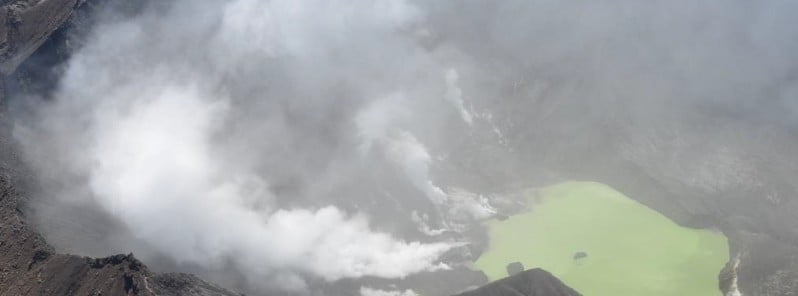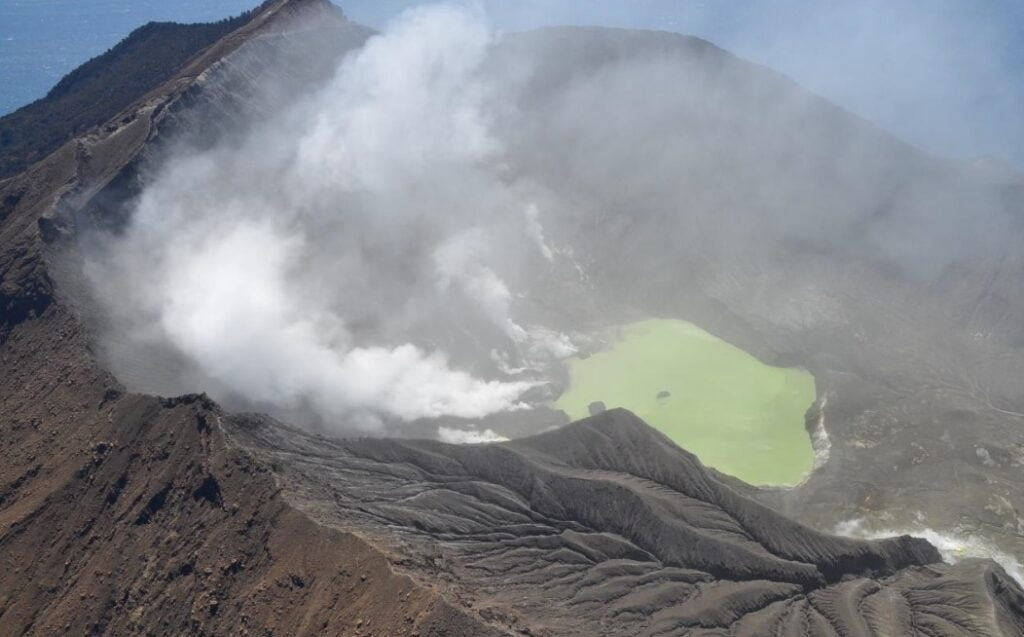Steam and gas plume emissions at White Island volcano, New Zealand

An observation flight confirms the active vents at New Zealand’s White Island volcano are continuing to emit a moderate steam and gas plume, with rare periods of ash emission. The Volcanic Alert Level remains at 2.
On October 19, 2022, GNS Science volcanologists observed a moderate gas and steam plume emitting from several sources behind the crater lake during a routine observation flight. The temperature of the gas and steam plume was measured at 145 °C (293 °F), down slightly from 165 °C (329 °F) on October 5.
A gas observation flight on October 7 measured a low discharge rate of sulfur dioxide (SO2) of 217 ± 19 tonnes/day.
Minor, passive ash emissions are still occurring intermittently from an active vent and have been observed occasionally in satellite imagery. Deposits from minor ash emissions are confined to the inner crater walls.

The North Rim web camera remains obscured by a thin ash coating.
“The Volcanic Activity Level remains at Level 2 (moderate to heightened unrest) and the Aviation Colour Code at Yellow, acknowledging the current level of activity, but also continuing to acknowledge the greater level of uncertainty in our interpretation due to the current lack of consistent, useful real-time data,” GNS Science Duty Volcanologist Craig Miller noted.1
“As the weather allows, we have increased the frequency of our gas and observation flights to the island until we can service our on-island equipment and power supplies. We still have intermittent access to webcams images from the island, providing some level of visual monitoring between our flights.”
Geological summary
Uninhabited 2 x 2.4 km (1.2 x 1.5 miles) White Island, one of New Zealand’s most active volcanoes, is the emergent summit of a 16 x 18 km (10 x 11.2 miles) submarine volcano in the Bay of Plenty about 50 km (31 miles) offshore of North Island.
The island consists of two overlapping andesitic-to-dacitic stratovolcanoes; the summit crater appears to be breached to the SE, because the shoreline corresponds to the level of several notches in the SE crater wall. Volckner Rocks, four sea stacks that are remnants of a lava dome, lie 5 km (3.1 miles) NNE.
Intermittent moderate phreatomagmatic and strombolian eruptions have occurred throughout the short historical period beginning in 1826, but its activity also forms a prominent part of Maori legends.
Formation of many new vents during the 19th and 20th centuries has produced rapid changes in crater floor topography. The collapse of the crater wall in 1914 produced a debris avalanche that buried buildings and workers at a sulfur-mining project.2
References:
1 Whakaari/White Island: Minor ash emission continues. Volcanic Alert Level remains at Level 2. – GeoNet – October 26, 2022
2 White Island – Geological summary – GVP
Featured image credit: GeoNet

Commenting rules and guidelines
We value the thoughts and opinions of our readers and welcome healthy discussions on our website. In order to maintain a respectful and positive community, we ask that all commenters follow these rules:
We reserve the right to remove any comments that violate these rules. By commenting on our website, you agree to abide by these guidelines. Thank you for helping to create a positive and welcoming environment for all.